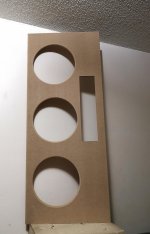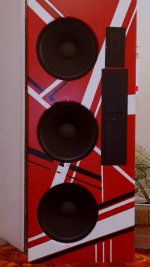Baffle dimension is very important factor when designing and evaluating open baffle speakers. A semi-open box like NOLA uses is weird and the N frame in the previous post works right only below 1000Hz - and are very prone to resonances.
Soundwave length variation in music is the problem here, soundwave bending and summation must be undestood well. That is why best results come from 3-4 way speakers with variable baffle width/dimensions. A narrow open line needs a different solution for mid- bass below say 300Hz.
Good reading here
Electro-acoustic models
Tech
Dipolplus - Alles über offene Schallwände
Soundwave length variation in music is the problem here, soundwave bending and summation must be undestood well. That is why best results come from 3-4 way speakers with variable baffle width/dimensions. A narrow open line needs a different solution for mid- bass below say 300Hz.
Good reading here
Electro-acoustic models
Tech
Dipolplus - Alles über offene Schallwände
An externally hosted image should be here but it was not working when we last tested it.
Last edited:
322
Sort of winging the baffle size for this.
Tested the concept with a 16x48" baffle, with the midranges and tweeters just screwed to the side of the try baffle.
Still awaiting delivery on a second pair of Neo 10 Bohlender Graebeners.
Still awaiting delivery of 4 Celestions 1525e-4, 15 " woofers.
Made two of these tonight, but I'm too lazy to cut out the tweeter holes.
The plan is, a Neo 8 ( I think mine are PDRs) splitting treble with a Neo 3PDR, 1 slope passive at 6000 Hz, actively crossed 4 slope to two BG Neo 10s, at 2500hz, actively crossed to the woofers, also 4 slope, at 175hz.
The two tweeters will share an amp channel, as will the two midranges, and will be vertically biamped with some nice little class a amps, 15 watts into 4 ohm loads.
The mixing of a total of two 4 ohm bass drivers, and one 8 ohm bass driver per channel allow for a few wiring and amping options, but I will start with them as a 4 ohm load, and a stereo Behringer A500 I've had around for a while.
This started out as a smaller alternative to my home made Onkens, with 511B and B+C horns.
Now they'll be a couple inches wider, and taller, at 24.5" wide, and 60" tall.
I'm hoping these will match the Onkens for dynamics, be a little smoother, and have better bass, that's less intrusive on my apartment neighbours.
Sort of winging the baffle size for this.
Tested the concept with a 16x48" baffle, with the midranges and tweeters just screwed to the side of the try baffle.
Still awaiting delivery on a second pair of Neo 10 Bohlender Graebeners.
Still awaiting delivery of 4 Celestions 1525e-4, 15 " woofers.
Made two of these tonight, but I'm too lazy to cut out the tweeter holes.
The plan is, a Neo 8 ( I think mine are PDRs) splitting treble with a Neo 3PDR, 1 slope passive at 6000 Hz, actively crossed 4 slope to two BG Neo 10s, at 2500hz, actively crossed to the woofers, also 4 slope, at 175hz.
The two tweeters will share an amp channel, as will the two midranges, and will be vertically biamped with some nice little class a amps, 15 watts into 4 ohm loads.
The mixing of a total of two 4 ohm bass drivers, and one 8 ohm bass driver per channel allow for a few wiring and amping options, but I will start with them as a 4 ohm load, and a stereo Behringer A500 I've had around for a while.
This started out as a smaller alternative to my home made Onkens, with 511B and B+C horns.
Now they'll be a couple inches wider, and taller, at 24.5" wide, and 60" tall.
I'm hoping these will match the Onkens for dynamics, be a little smoother, and have better bass, that's less intrusive on my apartment neighbours.
Attachments
Last edited:
Baffle dimension is very important factor when designing and evaluating open baffle speakers. A semi-open box like NOLA uses is weird and the N frame in the previous post works right only below 1000Hz - and are very prone to resonances.
Soundwave length variation in music is the problem here, soundwave bending and summation must be undestood well. That is why best results come from 3-4 way speakers with variable baffle width/dimensions. A narrow open line needs a different solution for mid- bass below say 300Hz.
Good reading here
Electro-acoustic models
Tech
Dipolplus - Alles über offene Schallwände
An externally hosted image should be here but it was not working when we last tested it.
looks familiar
looks familiar
Form follows function.
Has anyone tried a satin or semigloss latex paint on their projects?
I plan to paint my baffles à la Eddie Van Halen's guitar scheme, red field, black and white stripes.
I ask, because I'm hoping some car wax and a buffing pad will shine things up, without me needing to outsource the painting to a shop.
I dunno about car wax and buffing pad on latex paint????
Did a test, and it works fine. Not able to set up a spray booth in my apartment, and every polyurethane finish winds up with dust particles in it. This way, an inexpensive cut polish leaves a very good surface.
Maybe like this "WAFY" speaker, 40 cm wide, 75 cm high, 25 cm deep...
Eminence Neo 15 inch +visaton 130 mm and a low distorsion home built treble planar.
Sensitivity is around 90 dB and this speaker is the only one that I'm happy with after testing many speakers, through almost 35 years, factory made and Diy.
I can also provide the very simple but optimum 6dB cross over schematics.
That looks like a very nice bedroom loudspeaker. Can you share some more of the design, drivers used, crossover, that kind of stuff. I see you us your own planars. I have some spare AMT’s waiting to be used.
..mm,
Van Halen fan?
Absolutely.
Plus, I didn't want another veneer struggle.
I can change this out, easily.
Sweet!
Dual 15 subs and 15 mid... must have some impact.
Got a close up of the XO plate? Just for fun!
I also use my OBs for 2-channel music, and 5.1 movies. Love the sound.
Happy listening.

Apple's or oranges?
Nice job on the crossover. I've abandoned passive crossovers, as I need to adjust crossover points on the fly. The character of a driver may change, depending on where it's crossed, and I lack the skill to judge this from specs or modeling. I wish I have that talent: a passive crossover has a lower parts count to push a signal through, than active ones, and a lower amp count!
Just got my first electrical bill, after running 3 little Class A 10 watt amps, and an A/B one for a sub. Along with a note stating I've used 47% more electricity than the previous billing cycle.
Nice job on the crossover. I've abandoned passive crossovers, as I need to adjust crossover points on the fly. The character of a driver may change, depending on where it's crossed, and I lack the skill to judge this from specs or modeling. I wish I have that talent: a passive crossover has a lower parts count to push a signal through, than active ones, and a lower amp count!
Just got my first electrical bill, after running 3 little Class A 10 watt amps, and an A/B one for a sub. Along with a note stating I've used 47% more electricity than the previous billing cycle.
MIT, please consider moving to Edmonton! Heat from amps won't get wasted then!
♨️
- Home
- Loudspeakers
- Multi-Way
- Ultimate Open Baffle Gallery




